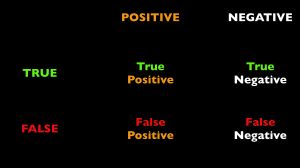Accuracy
Consider a classification problem. You have a group of animals, and you must classify each animal as either a cat or a dog.
There are two ways this could go right, and two ways this could go wrong, make for four possible outcomes.
- You correctly classify a dog as a dog.
- You correctly classify a cat as a cat.
- You incorrectly classify a dog as a cat.
- You incorrectly classify a cat as a dog.
Abstracting to Dogs and Not-Dogs
Now. Let's abstract our problem out a little. Let's say you're governed by Sirius, the Dog Star, and to you the entire world is made up of dogs and not-dogs. This slightly changes your classification problem, because now you're only interested in the dogs. Once something is not a dog, it could be a cat or an elephant. It's all the same to you. So, the adjusted four outcomes are:
- You correctly classify a
dogas adog. - You correctly classify a
not-dogas anot-dog. - You incorrectly classify a
dogas anot-dog. - You incorrectly classify a
not-dogas adog.
Nomenclature
Let's abstract a little further. Instead of dogs and not-dogs, let's call the classifications positive (oh hurrah - a dog!) and negative (dang, it's not a dog), and let's call the judgement of the classifications true and false. So our nomenclature has morphed like this:
dog -> dog -> positive
cat -> not-dog -> negative
correct -> correct -> true
incorrect -> incorrect -> false
And we can make a little table of how these things could go that looks like this:
Confusion Matrix

These tables are called confusion matrices. Best not to ask why.
The Problem of Accuracy
Where this gets interesting is with regard to the question of accuracy. Accuracy, in theory, is your number of correct predictions expressed as a ratio of your total predictions:
$$ Accuracy=\frac{true\ positives\ +\ true\ negatives}{true\ positives\ +\ false\ positives\ +\ true \ negatives\ +\ false\ negatives} $$
And that's fine, if the world is evenly divided between dogs and not-dogs. But the world isn't evenly divided between dogs and not-dogs - for every dog, there are many, many not-dogs. If there are 99 not-dogs for every dog, then you can classify everything as not-dog and claim 99% accuracy in your calculation.
This is one of the perpetual problems in statistics, the friction that is inevitable when the perfect world of mathematics meets the less-then-perfect world of material reality.
Precision and Recall
For which reason, there two other measure of accuracy, precision and recall.
$$Precision=\frac{true\ positives}{true\ positives\ +\ false\ positives}$$
$$Recall=\frac{true\ positives}{true\ positives\ +\ false\ negatives}$$
In the example above, where everything is classified as not-dog, precision stays about the same, but recall falls through the floor, indicating the flaw in the methodology.
It seems a subtle point, but consider an example other than dogs and not-dogs. Consider a classification not of animals, but viruses. The amount of viruses in the air is very low, existing in the same ratio as dogs to not-dogs in the world. But reader, consider what happens if you take a virus like Ebola or Marburg, and your classifier classifies it as negative when it should have been classified positive - what then? What use your accuracy then, when Death mounts his pale horse to gather his grisly harvest?